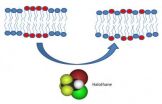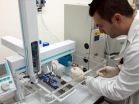A series of scans conducted while second- and third-grade students did addition and subtraction revealed that those who feel panicky about doing math had increased activity in brain regions associated with fear, which caused decreased activity in parts of the brain involved in problem-solving.
"The same part of the brain that responds to fearful situations, such as seeing a spider or snake, also shows a heightened response in children with high math anxiety," said Vinod Menon, PhD, the Stanford professor of psychiatry and behavioral sciences who led the research.
In their new study, which published online March 20 in Psychological Science, a journal of the Association for Psychological Science, Menon's team performed functional magnetic resonance imaging brain scans on 46 second- and third-grade students with low and high math anxiety. Outside the fMRI scanner, the children were assessed for math anxiety with a modified version of a standardized questionnaire for adults, and also received standard intelligence and cognitive tests.
Math anxiety is an under-studied phenomenon, Menon said, which still lacks formally established diagnostic criteria. Tests for math anxiety ask people about their emotional responses to situations and problems involving math. Those with high levels of math anxiety respond to numerical problems with fear and worry, and also say they are anxious about situations such as being asked to solve a math problem in front of a class. Menon noted that it is possible for someone to be good at math, but still suffer from math anxiety. However, over time, people with math anxiety tend to avoid advanced classes, leaving them with deficient math skills and limiting their career options.
While prior research focused on the behavioral aspects of math anxiety, Menon and his team wanted to find biological evidence of its existence.
"It's remarkable that, although the phenomena was first identified over 50 years back, nobody had bothered to ask how math anxiety manifests itself in terms of neural activity," Menon said. His team's observations show that math anxiety is neurobiologically similar to other kinds of anxiety or phobias, he said. "You cannot just wish it away as something that's unreal. Our findings validate math anxiety as a genuine type of stimulus- and situation-specific anxiety."
Identifying the neurologic basis for math anxiety may help to develop new strategies for addressing the problem, such as treatments used for generalized anxiety or phobias.
"The results are a significant step toward our understanding of brain function during math anxiety and will influence development of new academic interventions," said Victor Carrion, MD, a pediatric psychiatrist at Lucile Packard Children's Hospital and an expert on the effects of anxiety in children. Carrion, who was not involved in Menon's research, is also an associate professor of psychiatry and behavioral sciences at Stanford.
Menon's team decided to study young children with math anxiety to gain perspective on the developmental origins of the problem. (Prior behavioral studies had been limited to older children and adults.) First, the researchers modified a questionnaire that measures math anxiety to make it suitable for 7- to 9-year-olds. The study subjects were ranked by their scores and divided into high and low math anxiety groups for comparison. Children in the high and low math anxiety groups had similar IQ scores, working memory, reading and math abilities, and generalized anxiety levels.
The kids performed addition and subtraction problems while their brains were scanned using fMRI. In the children with high math anxiety, the scans showed heightened activity in the amygdala, the brain's main fear center, and also in a section of the hippocampus, a brain structure that helps form new memories. They also had decreased activity in several brain regions associated with working memory and numerical reasoning. Interestingly, analysis of brain connections showed that, in children with high math anxiety, the increased activity in the fear center was driving the reduced function in numerical information-processing regions of the brain. Further, children with high math anxiety also showed greater connections between the amygdala and emotion-regulating regions of the brain.
The two groups also showed differences in performance: Children with high math anxiety were less accurate and significantly slower at solving math problems than children with low math anxiety.
The results suggest that, in math anxiety, math-specific fear interferes with the brain's information-processing capacity and its ability to reason through a math problem.
In addition to examining possible treatments and following the trajectory of math anxiety from early childhood throughout schooling, future research could provide insight into how the brain's information-processing capacity is affected by performance anxiety in general, Menon said.
Menon's collaborators at Stanford were research assistants Christina Young and Sarah Wu.
The study was funded by grants from the National Institutes of Health and the National Science Foundation. More information about the Department of Psychiatry and Behavioral Sciences, which also supported this research, is available at http://psychiatry.stanford.edu/.
Future studies of math and brain function:
Menon's lab is now looking for children ages 7 to 12 in the San Francisco Bay Area for several brain studies, including studies of math anxiety, math cognition and memory formation. The researchers are especially seeking second- and third-graders who have difficulty with math for a study in which a month of free math tutoring will be provided.
They are also seeking children with high-functioning autism as well as typically developing children to serve as control subjects for ongoing studies of math, language and social abilities.
Studies involve cognitive assessments and MRI scans. Eligible children will receive pictures of their brain and $50-200 for participation. An MRI scan is a safe, non-invasive procedure that does not use radiation or any injections.
###
To participate, please visit http://mathbrain.stanford.edu, or contact Leslie McNeil at smp@stanford.edu or (650) 736-0128.
The Stanford University School of Medicine consistently ranks among the nation's top medical schools, integrating research, medical education, patient care and community service. For more news about the school, please visit http://mednews.stanford.edu. The medical school is part of Stanford Medicine, which includes Stanford Hospital & Clinics and Lucile Packard Children's Hospital. For information about all three, please visit http://stanfordmedicine.org/about/news.html.
PRINT MEDIA CONTACT: Erin Digitale at (650) 724-9175 (digitale@stanford.edu)
BROADCAST MEDIA CONTACT: M.A. Malone at (650) 723-6912 (mamalone@stanford.edu)
END

